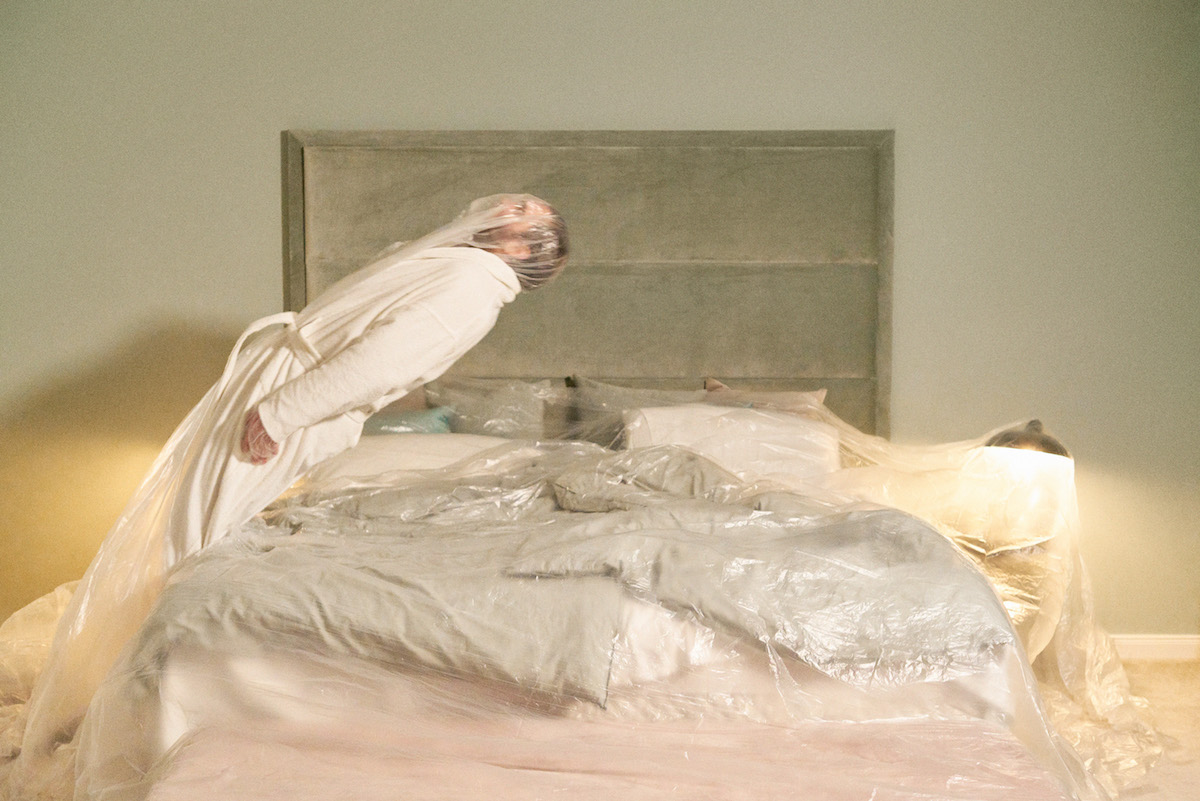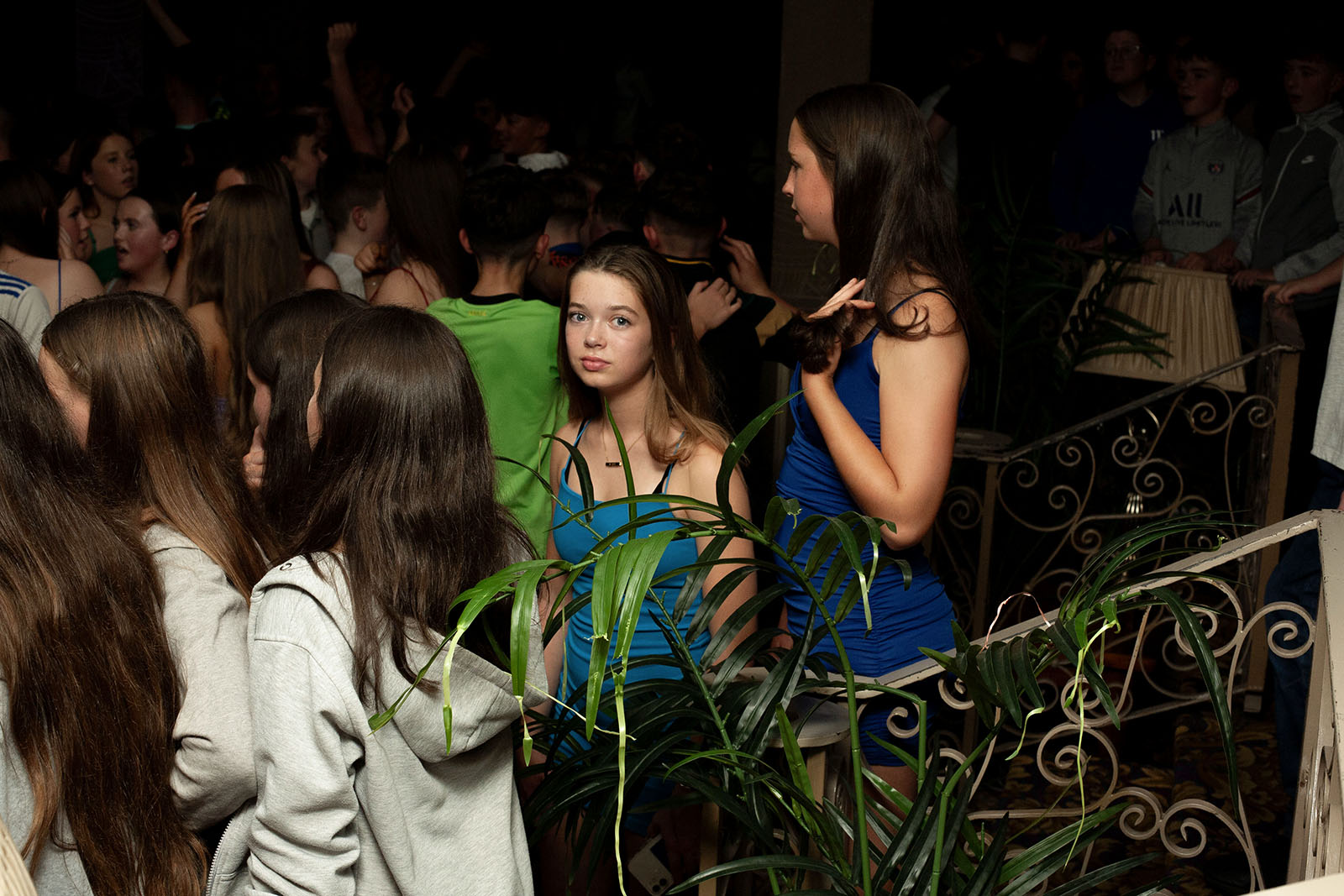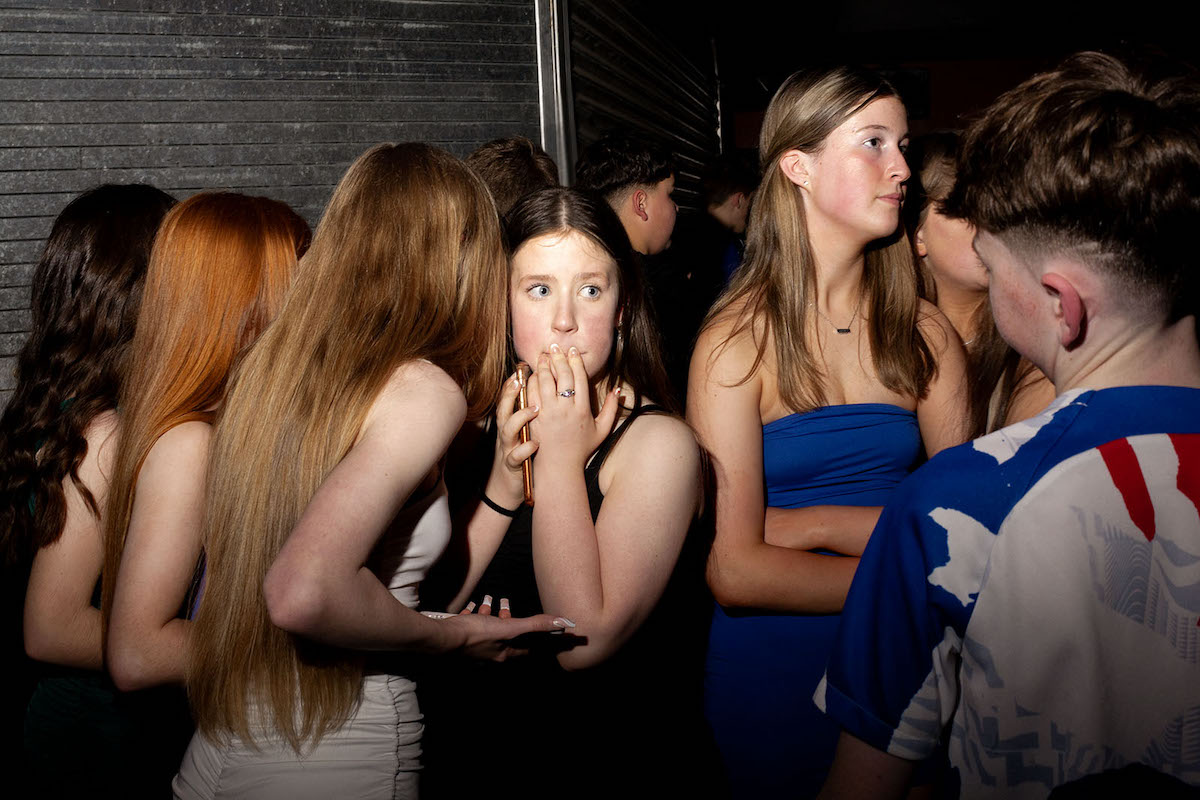Stored

The series produces an eerie prediction for what's to come. "A day in summer 2020. Social isolation has become normal. The new disease is called hypochondria," says Roché.
Check out the rest of the series below.
Stay informed on our latest news!

The series produces an eerie prediction for what's to come. "A day in summer 2020. Social isolation has become normal. The new disease is called hypochondria," says Roché.
Check out the rest of the series below.














When I spoke to Lynch, she had just moved to Brighton, England, seeking a balance between city life and the ‘nothingness’ she experienced growing up in Ireland. We talk about the return of cheap bodycon dresses, Trainspotting, and erasing boys from the frame. Read our conversation below.
Julia Silverberg— When I was looking through the images you sent over from Girls' Night, one stood out: there was a girl wearing fishnet sleeves with her jacket tied around her waist.
Eimear Lynch— When I took that image, I knew I was caputuring something rare. At these events, everyone tends to dress the same, but that girl stood out even though some of her friends had similar outfits. She looked amazing and had such a sweet demeanor, just quietly observing the party. I met her at one of the discos where everyone was only 13 or 14, so it was probably her first time at a party like that. She and her friends were cooler and happier than the rest, and in that portrait, she just seemed so content with herself.
Did you notice ways in which the girls who were wearing the disco "uniform" still managed to assert their individuality?
Honestly, I feel like they didn't have any takes on the look — if they were wearing the bodycon dress, they were wearing the bodycon dress. I was the same at that age; it wasn't until I got a bit older that I started experimenting with my hair and clothes. During my first year of going to discos, I just wore the standard dress from ASOS, but I think it’s a rite of passage. At that age, I wasn’t thinking about looking cool, I just wanted to finally be a woman and wear the dress.
It’s funny because I still have this H&M dress from my first teen party. Sometimes I try to find a way to style it now and make it cool again.
They’re kind of making a comeback! Some of the colors are amazing, but the material of those cheap dresses is so shit. Back then, my friends and I also all wore these really ugly heels that we couldn’t walk or dance in, but now, teenagers are smarter. You still see some of the same looks, but the girls are all wearing trainers — Nike Air Maxes and Converse are the big ones.
Do you think your book challenges the idea of getting ready as an overly feminine ritual?
In an ideal world, there wouldn’t be any beauty standards or pressure to wear makeup and do your hair. But since they exist in a patriarchal society, I want to celebrate the good that can come from them. The hours spent getting ready are so fun, and boys don’t usually get to experience that. There are benefits from the pressures on us, and that’s something to be celebrated.
You often work around female identity in this way.
I’m still quite new in my career and doing a lot of self-reflection; that’s why I’m focusing on girlhood and the experience of being a girl. Maybe once I feel like I’ve fully explored that, I’ll move on to something else, but for now, I want to delve into what I know and understand. At this point, looking at my own life and upbringing through my work is a lot more authentic for me.


Did you learn anything specifically about femininity from your work on Girls' Night?
The book really reminded me of how important female friends are, and how essential it is to have a good group of people around you. I think girls can get a bad rep for being bitchy, but the ones that I photograph are all so lovely to each other. This new generation is really aware of mental health whereas when I was a teenager, people didn't realize that being mean was a bad thing. Now, people are a lot more supportive of each other, which I think is amazing. Also, when I was in some of the girls’ bedrooms, they would talk about boys, but they wouldn't talk about them as if they were chasing after them. They were talking like, if I kiss this guy, it happens, whatever. They weren't obsessing over them, which I found really interesting and different from when I was their age. They seemed like they had the control.
How did you manage to capture such vulnerability in your work? None of the images feel performative.
Some of the girls were a bit harder to get to relax, but most of them forgot I was there pretty quickly. The people in the photos were real groups of friends meeting up after school; I was just an addition to their night out. Sometimes we’d chat while they were getting ready, but most of the time, I’d say, “pretend I’m not here”, and then I’d snap away. They don’t get to hang out much because they’re in school all the time, so they were busy catching up with each other. At the clubs, I’d do laps to make sure everyone saw me, smiling, and trying to look welcoming. During the first hour, people were usually too on edge for photos, but once they got used to me, I could capture those more intimate moments.
Do you think the backdrop of the current economic crisis influences how we romanticize those moments from our youth?
Nostalgia is always a powerful feeling, and it’s something that resonates with me in other people’s work — it’s an important part of art and films. With my project, teenage girls haven’t been documented solely like this before, and that’s what resonates with people. There’s this view of youth culture, especially boyhood, in a Trainspotting way, where boys are being bold and running around. Because of this, I wanted to show that girlhood has its own exciting aspects. I tried to create a realistic look at growing up as a girl in Ireland, and those feelings of transition connect with everyone. Your photography captures that tension between the carefree aspects of our teen years and the approaching realities of adulthood. That transition is really apparent in the awkwardness of the girls’ poses and stances. In my photos, they seem unaware of the impending weight of becoming a woman. They’re so confident while getting ready and heading to the discos, but once there, they’re so insecure.
My friends and I were so eager to be older at that age.
It’s fun to be excited about getting older — why not? At 13, 14, 15, going out is the best thing ever. It’s when you’re 16 or 17 that things get more complicated, going out isn’t the same, and you become very conscious of how you look. The younger girls, though, are wearing a dress and makeup for the first time, so they just think they look amazing.
I also noticed you cut the boys out of the picture. Why?
When I was a teenager, the only bad experiences I had were because of boys. A lot of my insecurities stemmed from them being mean; I never had those issues with my girlfriends. I was always a confident kid, but around 16, boys really broke me, and left me with a bad feeling about that age. Because of that, I wanted to focus on the good parts of my teenage years — picking out dresses, doing hair and makeup with my girls — and cut the boys out.


I like this idea of reclaiming your own teen years. Do you think that makes the book an idealization of that time?
It’s definitely not a factual documentation since the boys aren’t included. Maybe one day I’ll go back and do a version of the book highlighting them, because there are interesting stories to be told there too.
The project is so clearly specific to you, especially with it being set in local churches and community centers around Ireland. How did these locations influence the narrative of the book?
Going into the project, I thought there’d be big differences between the venues I shot, but most of them looked the same, especially with the lighting. It was also always funny to see people arriving and leaving at the discos, especially in the middle of nowhere in the countryside — no one wore a jacket! They’d wear their dresses, and their parents would drop them off and pick them up. Surprisingly, this energy was quite uniform all around Ireland.
Do you remember where your teenage disco took place?
I went to a venue called Wes in Dublin, but sadly it’s closed down now because I’d love to go back. It was in an old rugby club, and I remember it being so sticky. The walls were sweaty, and at the end of the night, we’d push each other against them, and they’d be full of condensation.
I feel like that's what someone thinks of when you say “teen discos”, it’s…
Very grimy.
How do you think the themes of Girls Night will be perceived by future generations?
I hope the images will always be relevant, and want people to connect with them in the coming years. I’m surprised by how similar everything I captured is to when I was going to discos 15 years ago, but I do think the uniformity will stop. People will start to be more stylish and wear their own things. You can already see the push towards taking more risks, like wearing funky eyeshadows and lipsticks. I never did that when I was younger, but people are learning more from TikTok and Instagram.
Maybe if you redo this project in 15 years, you’ll get a completely different outcome.
Yeah, hopefully. I want younger people to look at the book and think it’s crazy that everyone used to wear the same outfit.















What is your ideal office?
Nice people, natural light. Some sort of a coffee maker?
What role does uncertainty play in your design approach?
Uncertainty is a great power because it makes you push yourself. With each new project, we try to challenge ourselves, and never repeat something we have already done. To a certain degree all great work requires exploring an unknown territory. Type design is a lot about trial and error. It’s a process of constant iteration, and balancing between intuition and measured perfection. We are always uncertain how people will receive our work. From the business point of view, it’s never obvious what typeface will become popular.
Where might we find you on a Friday night?
Depends on the season. In winter we usually spend Friday nights unwinding, meeting friends or just staying home. Maybe go to the neighborhood bar? Both Berlin and Helsinki are great places for entertainment.
What unusual inspirations have unexpectedly influenced a font of yours?
Working on our latest typeface release items, one surprising source of inspiration came from a typeface on the cardboard packaging of Microsoft Windows from the early 90s.
If you could collaborate with any artist, dead or alive, who would it be?
Definitely Roy Orbison. Or Wu-Tang clan.
How do you deal with fear?
At the moment it feels that the world is at a state where fear has lost its significance. We are all in the middle of the scariest things: climate change, biodiversity loss, political instability and wars, growing economic inequality… It is important to use all of our collective efforts to fight global challenges. At the same time, it’s time to live and not fear and to take care of the people around you.
What is the last living thing you fell in love with?
We love all living things equally.
Mountains or beaches?
That’s a dilemma! Beaches — the repetitive sound of waves crashing on the shore has a meditative quality, inducing a state of relaxation and mindfulness. At the same time, the towering peaks of mountains evoke awe, fostering contemplation about the grandeur of nature and our place in the world.
Pair your favorite typeface with your favorite album:
Best typeface: Univers; Best album: Jimi Hendrix, Electric Ladyland
If you were to pass a future version of yourself in the street, what would you ask?
Do people still use typefaces?

Berlin-based artist Bernardo Martins, known online as @figa.link, has mastered this uneasy balance. Like the bizarre image of Wintour, his work leaves you questioning what’s real and what’s imagined. Martins uses AI to create haunting images that toe the line between the beautiful and the grotesque. Often returning to discomfort as his starting point, AI-image-making has enabled Martins to channel and more easily express his feelings, like the “deep melancholy he’s felt since entering adulthood." This raw, emotional honesty explains why his work resonates with so many. His distorted, otherworldly visuals communicate feelings and experiences that many struggle to articulate.
A few months ago, model and phenom Gabbriette reached out to Martins about working together, drawn to his "ENCOSTO" series, which he previously developed for the Arti_fiċial Pėrspėctivės exhibition curated by Nate Mohler at Los Angeles Center Studios. In Brazilian culture, "Encosto" refers to spirits that attach themselves to the living, influencing and altering their behavior or state of being. Drawing on this belief, Gabbriette’s appearance is both metaphorically and literally distorted — possessed and warped by metal spikes, chains, and claws.
Previously, all of Martins' models have been imaginary. Working with an actual subject for the first time presented a new challenge. It took about three months of collaboration to bring Gabbriette's likeness to the images. “I don't have a strict process I follow; the technology has developed so much and so fast that I constantly adapt to expand and improve the possibilities,” he explains. Usually, Martins spends about a week or so to get a good grip on what works and what doesn't, "but the possibilities of AI are so many that I try to keep everything connected to build a cohesive and complete world in expansion.”
The implications of AI-generated content have been divisive, raising questions about creativity, authorship and originality. Some wonder whether AI art can truly be considered real art. But perhaps the better question is: What is art, anyway? If the purpose of art is to make you feel, then Martins accomplishes just that. The ability for an artist to use AI image-making to bridge reality with our inner worlds is no different from a poet writing in stream of consciousness or a painter recalling their latest dream.
On that note, if AI-Gabbriette or mini-skirted, tommy gun-wielding Anna Wintour show up in your dreams tonight, I'm sorry.
View "ENCOSTO" below.






